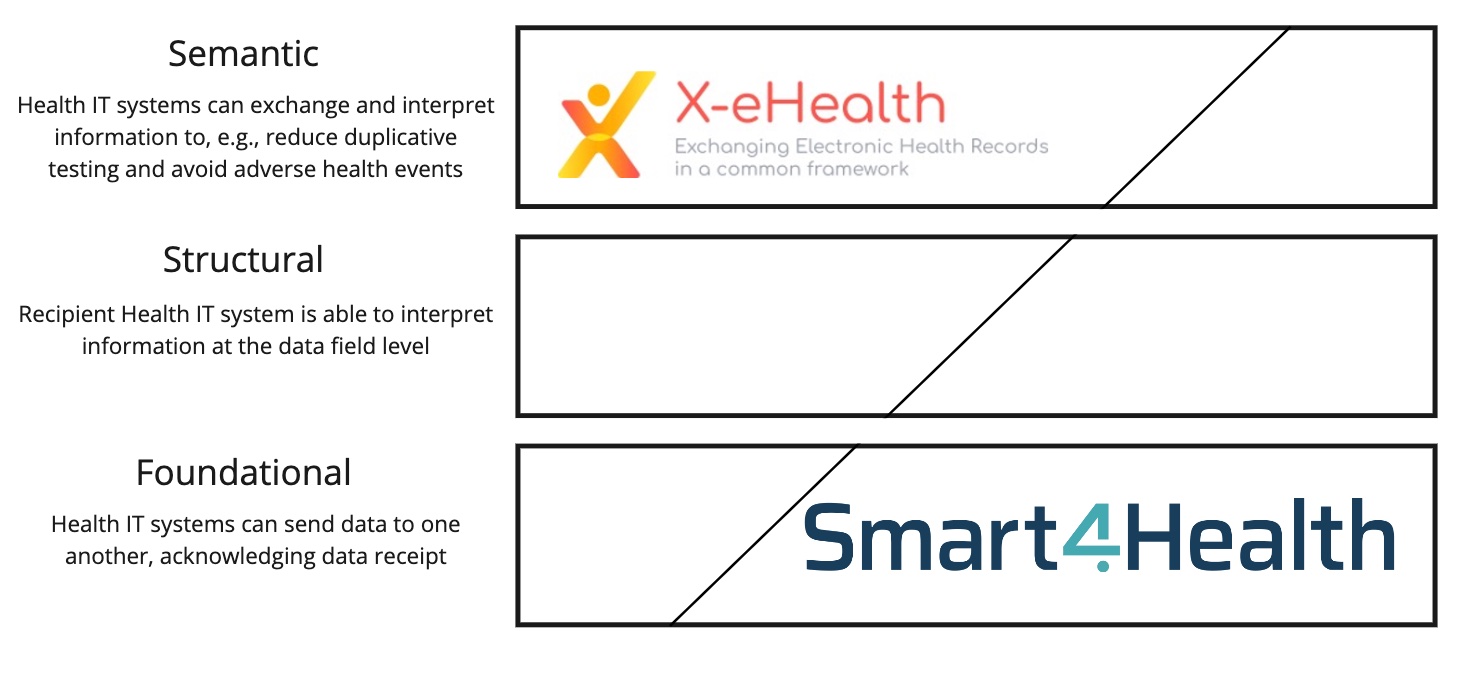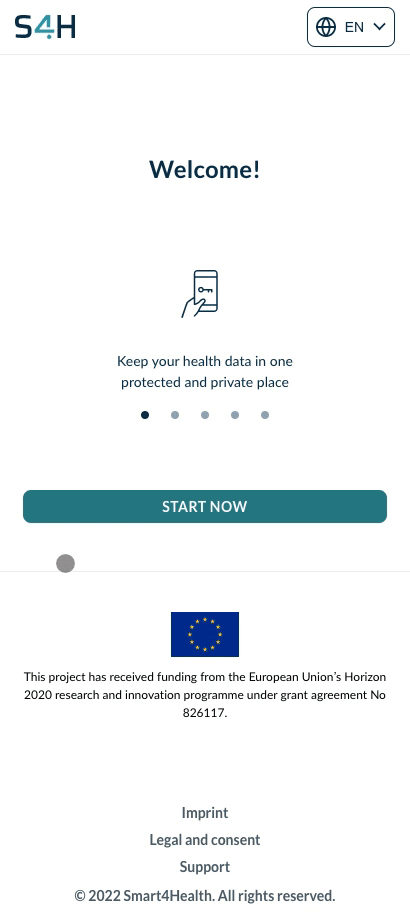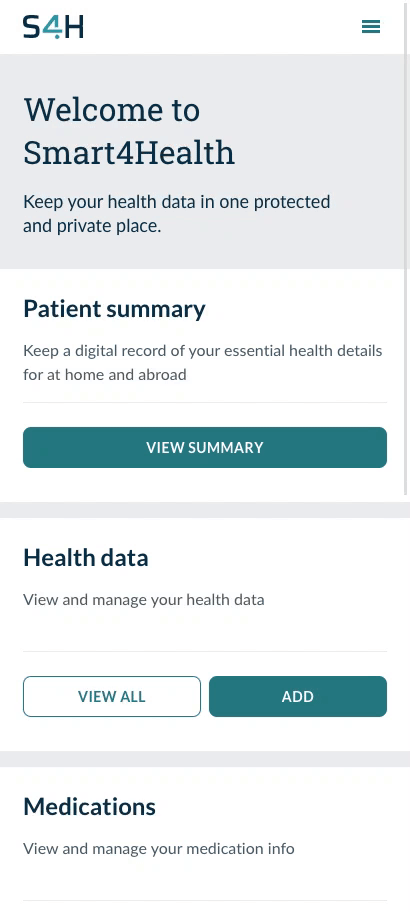The voting phase is open between 1. and 30. of September. You can support our project by voting in the X-eHealth site:
Smart4Health Application
Scope and goals of the project – and why it should be considered for this award
The Smart4Health project enables European citizens to collect their personal health data throughout Europe in one secure platform – the Citizen Health Data Platform (CHDP). Only the citizen owning the account can access the data, and decide if and when to share this data with trusted ones and health care professionals. In addition, the citizen can opt to make this data available to the scientific community in anonymized form. This enables citizens to gain personalised insights about their health.
In this way, Smart4Health enables citizens to manage and bridge their own health data throughout the EU and beyond, advancing their own and societal health and wellbeing. This citizen-centred EU EHR exchange for personalised health paves the way for the full deployment of citizen-centred solutions and services in the Digital Single Market for wellbeing and healthcare. It provides for interoperability, complementarity, and cooperativity with profiles that are currently used, e.g., by EU Member States and their regions. Smart4Health bridges between the diverse EU EHR data and citizen-generated health data. It connects citizens to personalised health services and to scientific activities.
Smart4Health must be considered for the X-eHealth interoperability award 2022 as it provides a unique approach to tackle interoperability. While other endeavours target hospital-to-hospital connectivity, we put the citizen at the centre, enabling them to retrieve their own data from multiple sources and sharing it via the platform. This approach is agnostic to country borders, and includes electronic translations to overcome language barriers.
Smart4Health addresses the priorities listed by the European Commission’s 2017 review of the Digital Single Market:
- Citizens’ secure access to electronic health records and the possibility to share it across borders.
- Supporting data infrastructure to advance research, disease prevention, and personalised health and care
- Facilitating feedback and interaction between patients and healthcare providers, to support prevention and citizen empowerment as well as quality and patient-centred care.
This is pursued with an outstanding multidisciplinary consortium including ICT developers, hospitals, social sciences researchers, physiotherapists, nurses, informal caregivers, regional government, research centres, universities, and SMEs. Together, the consortium develops, tests and validates the platform prototypes. This platform builds on the strength of the existing European infrastructure, the experience and knowledge gained and generated in the EU/US collaboration in eHealth, and the momentum of initiatives in the Member States.
Why “trust-inspiring” in the field of health data interoperability
The exchange of health records, e.g. originating at a healthcare provider, transferred to a citizen account and later being shared with a trusted other, requires visibility into how data is handled and processed as it enters different systems. A keystone for this visibility is the usage of the FHIR standard, being developed collaboratively by healthcare providers, citizens, legal regulators and technical experts. In the Smart4Health project, this is accompanied through a publicly-available FHIR Implementation Guide (IG). The IG is based on HL7’s International Patient Summary (IPS) IG (STU1 release), to provide a tested and trusted foundation for the data exchange. Where extensions were needed, also the Trillium II project IG was consulted to ensure alignment with previous work.
Excerpt of S4H FHIR Implementation Guide, available at https://simplifier.net/guide/smart4health
The Smart4Health IG forms the basis of the data model of the CHDP. A key differentiator that sets it apart from other standard off-the-shelf solutions readily available in the market, is its strong encryption and high data privacy and security considerations. The CHDP is developed following a security-by-design approach, in which the data is encrypted end-to-end: only the user has the key to decrypt the data in their accounts, making it impossible for platform operators to access the data at a logical level. The partner driving the development and operations of the platform is a non-profit organisation that has been certified by the German Federal Office for Information Security (BSI), in accordance with ISO 27001 since July 2019.
The Smart4Health Ethics, Legal and Governance Committee ensures that all the project’s activities are in keeping with the relevant national and European ethics issues and addressed correspondingly.
Why “innovative” in the field of health data interoperability
Smart4Health aims to take interoperability all the way to the individual citizen. Most interoperability work is focused on exchanging data between “big systems of big players”, such as hospitals and their clinical systems, laboratories, insurance companies, etc. We believe interoperability requires that a human actually understands and benefits from the information in the end. Therefore, we prioritise “the last mile interoperability”, e.g., by making complex interoperable structured data readable for non-specialists, and allowing the ingestion of structured data from citizen-owned devices.
Much of the core technologies in use in health and care are based on proprietary specifications or older standards that do not leverage modern web technologies. The Smart4Health CHDP is based on the modern FHIR standard, which has been growing in popularity and maturity since its inception. The cross-country interoperability has been further strengthened by use of the International Patient Summary, as well as the openly available SNOMED Global Patient Set, where possible, and SNOMED CT and LOINC, otherwise.
While the use of FHIR within healthcare processes is getting more traction, its application in a citizen-centred EHR exchange platform as core data format fosters its adoption and enables fulfilling compliance requirements such as Art. 20 of the General Data Protection Regulation, the “right to data portability”, where citizens have the right to receive the personal data concerning them in a structured, commonly used and machine-readable format.
Cross-border access to health data via the eIDAS framework
Visualization of health data including required sections of the International Patient Summary.
Why “technically excellent” in the field of health data interoperability
Within the Smart4Health project, best practice methods were used to build the FHIR Implementation Guide and make it openly accessible.
All FHIR artefacts published in this IG, including data examples, are released in the form of a FHIR package at regular intervals under the unique package ID smart4health.eu.core. Each release has a version assigned according to the rules of semantic versioning, and all released versions are listed and searchable in the FHIR package registry. Standard FHIR tooling (e.g., a command-line validator) can automatically pull these packages from the registry. The Smart4Health package can also be downloaded from the simplifier.net project page at https://simplifier.net/Smart4Health/~packages.
Making FHIR a core element of the platform while simultaneously offering an end-to-end encryption mechanism has an impact on the system architecture. For this reason, a multi-platform Software Development Kit (SDK) for web, Android, iOS and Java has been made available. This SDK enables application developers to focus on business value, instead of semantic data validation, encryption, networking, storage, and data durability. The Smart4Health project uses FHIR v4.0.1, the newest full release of FHIR.
In what way project is positioned to benefit from X-eHealth’s work
The X-eHealth project aims to develop the basis for a workable, interoperable, secure, and cross-border Electronic Health Record Exchange Format, in order to lay the foundation for the advance of eHealth.
It is common to think of interoperability in terms of different levels: foundational, structural, and semantic. As depicted below, Smart4Health and the X-eHealth projects are complementary in these three levels, with Smart4Health focusing more on the validation of a prototype that implements cross-border specifications, and X-eHealth more on the actions required by organisations, e.g. to make the EEHRxF specifications a reality.

Smart4Health is well positioned to address important technical and societal aspects elaborated in the X-eHealth project, such as the use of citizen’s electronic identities to access health data, or the ability to securely share health records using a friendly user interface in multiple European languages. Smart4Health is positioned to benefit from outcomes and findings of the X-eHealth project, e.g. as shared in deliverables.
We plan to conduct a systematic assessment of the level of interoperability of the specifications so-far produced in the X-eHealth project and report on these publicly. Also, Smart4Health is ready to serve as a role model for checking the feasibility and verify in realistic scenarios how the EEHRxF can be used to serve concrete integration functions. Through this process, we can provide lessons learned, validations, and improvements to the EEHRxF. Possible scenarios are establishing connections with healthcare providers via the Smart4Health Connector to the CHDP, and connecting mobile applications to add other health-related data utilising the SDKs.


